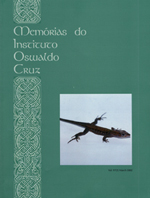
|
Memórias do Instituto Oswaldo Cruz
Fundação Oswaldo Cruz, Fiocruz
ISSN: 1678-8060
EISSN: 1678-8060
Vol. 111, No. 5, 2016, pp. 294-301
|
 Bioline Code: oc16043
Bioline Code: oc16043
Full paper language: English
Document type: Research Article
Document available free of charge
|
|
|
Memórias do Instituto Oswaldo Cruz, Vol. 111, No. 5, 2016, pp. 294-301
| en |
Respiratory syncytial virus seasonality in Brazil: implications for the immunisation policy for at-risk populations
Freitas, André Ricardo Ribas & Donalisio, Maria Rita
Abstract
Respiratory syncytial virus (RSV) infection is the leading cause of hospitalisation for respiratory diseases among
children under 5 years old. The aim of this study was to analyse RSV seasonality in the five distinct regions of
Brazil using time series analysis (wavelet and Fourier series) of the following indicators: monthly positivity of the
immunofluorescence reaction for RSV identified by virologic surveillance system, and rate of hospitalisations per
bronchiolitis and pneumonia due to RSV in children under 5 years old (codes CID-10 J12.1, J20.5, J21.0 and J21.9).
A total of 12,501 samples with 11.6% positivity for RSV (95% confidence interval 11 - 12.2), varying between 7.1 and
21.4% in the five Brazilian regions, was analysed. A strong trend for annual cycles with a stable stationary pattern
in the five regions was identified through wavelet analysis of the indicators. The timing of RSV activity by Fourier
analysis was similar between the two indicators analysed and showed regional differences. This study reinforces the
importance of adjusting the immunisation period for high risk population with the monoclonal antibody palivizumab
taking into account regional differences in seasonality of RSV.
Keywords
respiratory syncytial virus; seasonality; palivizumab; time series analysis
|
| |
© Copyright 2016 - Memórias do Instituto Oswaldo Cruz
Alternative site location: http://memorias.ioc.fiocruz.br
|
|
